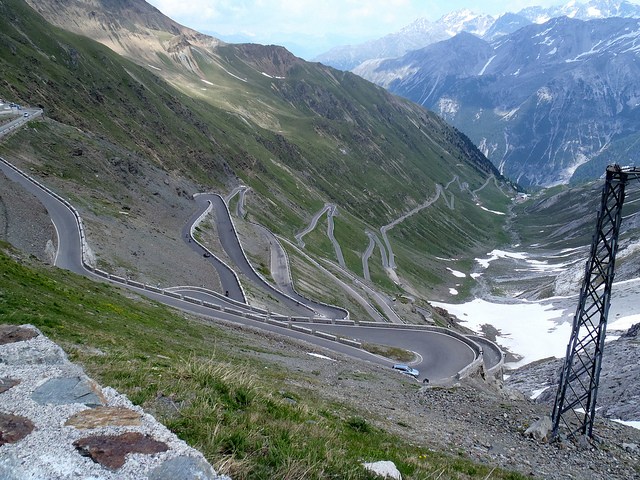Many thanks to Fiona Russell for this blog on our Marmot Tours Raid Dolomites in Sept 2017. For her original post, and many more, visit Fiona Outdoors
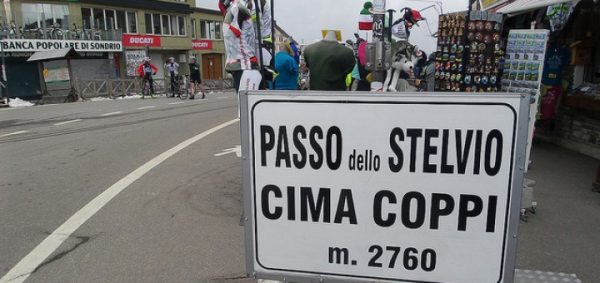
Classic Giro d’Italia Cycling
Of course, a cycling tour of the Italian mountains was going to include the epic Stelvio mountain pass in the Eastern Alps of Europe. It’s a classic ride of the Giro d’Italia and an impressive piece of road build engineering that takes drivers (and cyclists) to amazing heights.
Except, typically, I had not had a chance to closely read the Marmot Tours Dolomites guide notes before I left for Italy last week.
This meant that an ascent of the highest road pass in Europe, with its infamous 48 hairpins, was news to me the night before we were to ride the mountain pass.
In a bit of a panic I did what I normally do: Google search “Stelvio”.
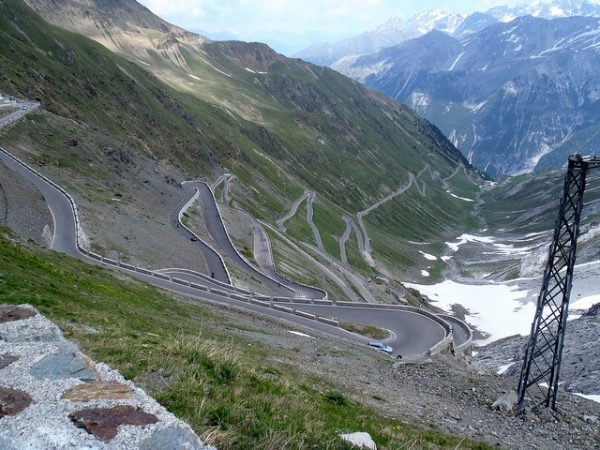
The first sight was a classic photo of the tight hairpins climbing in a ridiculously steep zigzagging line high up on an Alpine mountainside. I thought they looked beautiful, like a decorative line of royal icing clinging to the side of a cake, yet also unbelievably precarious, like a long winding length of rope that could undo at any moment.
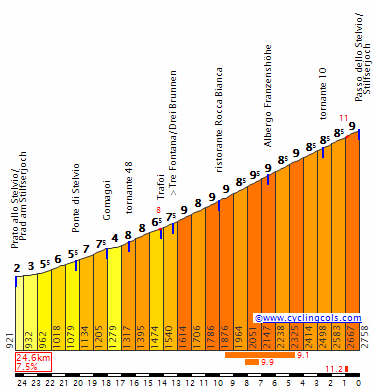
Ascending the Stelvio
I read the statistics: An ascent of the eastern side of the Stelvio from Prato Allo Stelvio amounts to 24km with 1817m of total ascent. The start at 941m, rises through gradients averaging at 8% and up to 10% to reach a summit of 2758m. (Note to self: That is more than twice the height of the UK’s highest mountain, Ben Nevis at 1345m.)
The top of Stelvio is also a point where Switzerland, Italy and Austria collide.
Fastest Strava time for Stelvio
Apparently, the fastest Strava time is 1hr 20mins by Marco Z, with the female record set at 1:36 by Peluchine P.
The Marmot Tours guides, Pedro and Tim reckoned our group would take between 2hrs 15 mins and 3 hrs 30 mins. I was hoping that my ascent would be around 2.5 hours but that really did seem like a lot of time riding uphill.
There was more anxiety to come.
As I turned my attention back to Pedro and Tim as they told us of the next day’s plans. I heard mention of an impending storm, an earlier than planned start, a three-hour coach ride to the base during which time we should stock up on food for energy and cautionary words about “riding in your own comfort zone”, “careful pacing” and “remembering to eat and drink”.
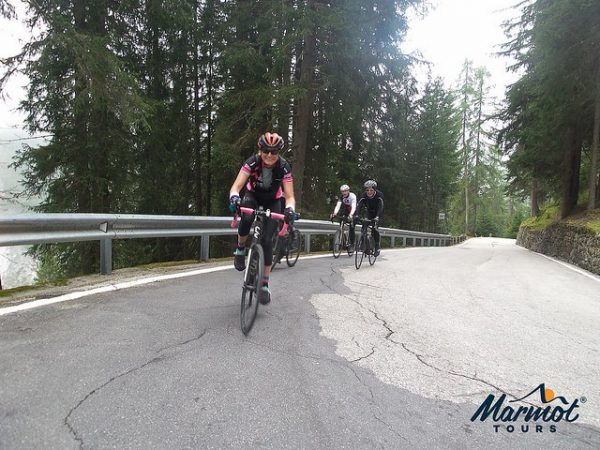
My ride of the Stelvio
I forced the words “pace yourself” to the front of my mind as I began the day’s ride of the Stelvio. “It’s only a couple of hours, or so, of riding uphill,” I reminded myself.
Then… “Jeeez… 2.5 hours? What on earth? That is mental. Most movies are shorter than that. I could drive between Glasgow and Edinburgh twice and still have time spare.” I pushed these thoughts away.
The cycle from the railway station at Prato to the official start of the climb is easy and rises fairly gently. As we set off, our group of 20 riders began to string out in a single file, everyone being careful with their pace.
Soon, some of the stronger riders in our group were edging away and the sensible thing was to let them go. As I saw them head into the distance I enjoyed the first few kilometres of the pass with its “easy” gradients of between 2% and 6%.
I settled properly into my own pace, paying little attention to others around me except to make sure I did not ride into anyone. I am usually good at pacing and for this climb I knew it would be vital to stay comfortable.
The picturesque valley scenery of pine forests and a noisy, tumbling mountain stream offered good distraction for the mind as we rode. I also found myself next to different people in our group and enjoyed exchanging a few cheery words.
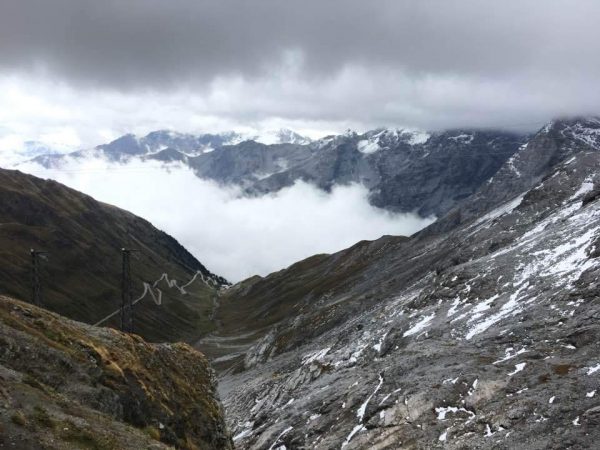
The going becomes a little tougher
The first harder section came around 4kms with a 6% average gradient and then some light relief of 5% before a couple more kms at 7%. Another km at 4% was welcomed and around this point I realised my Marmot Tours cycling pal, Ian, was staying with me.
He told me that he was sticking close to me because he thought I was good at pacing. The day before he had ridden too fast up a climb of the Maratona route and then suddenly “hit the wall” (aka “bonked”!) close to the top.
He told me: “I blew up yesterday on the Valporola and you then came cruising past me. If I stay with you today I will hopefully make it to the top comfortably.” So he did.
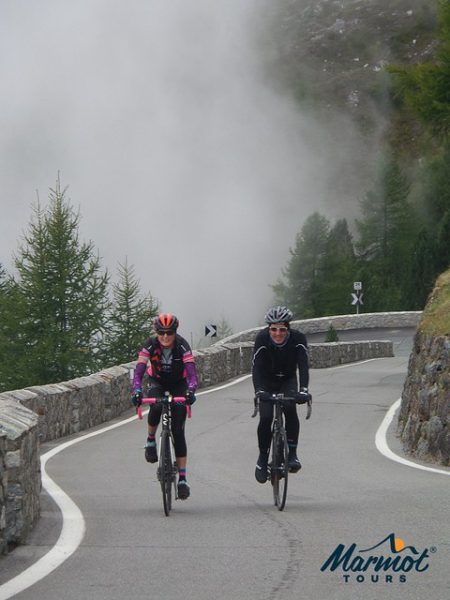
As the gradients steepened and the climbing time racked up, Ian and I settled into a routine of talking when we could and being silent when we had to push the pedals. We were silent more than we talked!
Gaining more height, I realised we had cycled into to a thick band of clouds. The forest views and surrounding mountains were swallowed by the mist and it felt like a surreal experience to be riding with only the immediate way ahead in view.
Perhaps it was better that we could not see the full extent of the hairpins up ahead but, still, we knew they were there waiting for us.
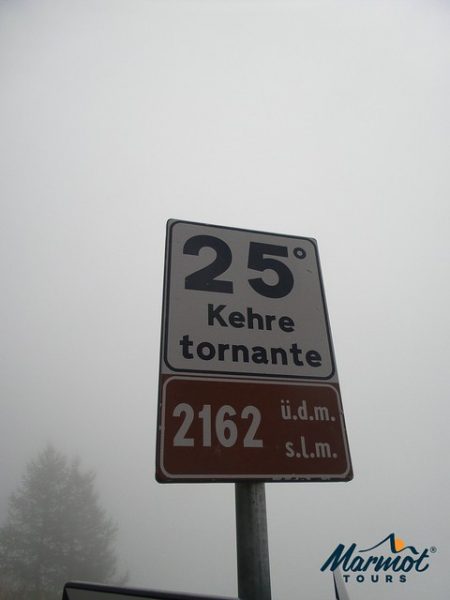
Counting down the Stelvio hairpins from 48
The first hairpin was marked with a small concrete sign as number 48. It seemed, at that stage, that I would never reach single numbers but really there was nothing more to do than try to turn the pedals and hope that the bends would come quickly and smoothly.
They didn’t. At bend 45 I was sure it would read 40. It didn’t. By bend 41 I was convinced the numbers were going up again and not down.
Then finally we started into the 30s. It was around hairpin 30-something that the clouds suddenly parted giving a full and breath-taking view of the tightly snaking tarmac of the higher altitude bends. Looking up, it seemed utterly incredible that we would be expected to ride so high and on such a steep road.
I muttered something along these lines to Ian and he quickly replied: “Don’t think about it. Just keep pedalling.”
I tried to do just that but every so often I would sneak another look up and feel my stomach churn and my heart drop. “WTF?” came to mind so many times.
I also thought about the building of the pass. The original road was built between 1820 and 1825 by the Austrian Empire to connect the former Austrian province of Lombardy with the rest of Austria. How on earth did they manage to build such a magnificent road back then?
At various intervals, Ian offered an update on the stats. “We’ve ridden about a third of the distance now.” “I think we are about half way up the climb”. Then he revealed we had some 15km to ride and a vertical gain of 1,000m. That is the same height as a Munro I thought. “That is ridiculous!”
I wondered, too, if any of the front riders in our group had topped out. My friend Hill Billy is a brilliant hill climber and I thought of him cycling easily to the summit. Nick, a superb cyclist aged 66, had passed Ian and I a long time ago and we could see him edging further ahead as we climbed. I hope I can ride as strongly as he does he my 60s.
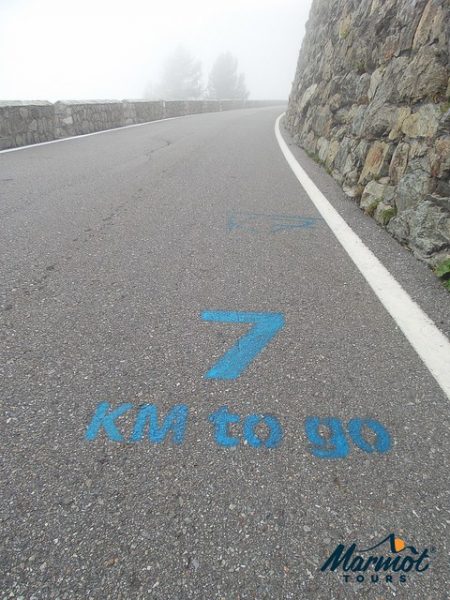
Riding up the final 20 or so bends
Another milestone came when we crept into the 20s for the hairpins. By now the gradients were relentlessly steep and fatigue was setting in. The Marmot vans were doing a fantastic job of keeping us company and offering snacks, water and stops when we wanted.
I had decided early on that I would not be getting off my bike. I managed to eat a sports bar while cycling and as I passed one of the vans I called out to Pedro to hand me a gel. I don’t like sports gels as a rule but it was needed for this climb.
Just as I was feeling like I really didn’t want to go on we rode out and above the cloud line. This gave another far more dramatic and close up view of the high-level hairpins but it felt superb to be able to see the peaks of the other surrounding mountains in this beautiful area.
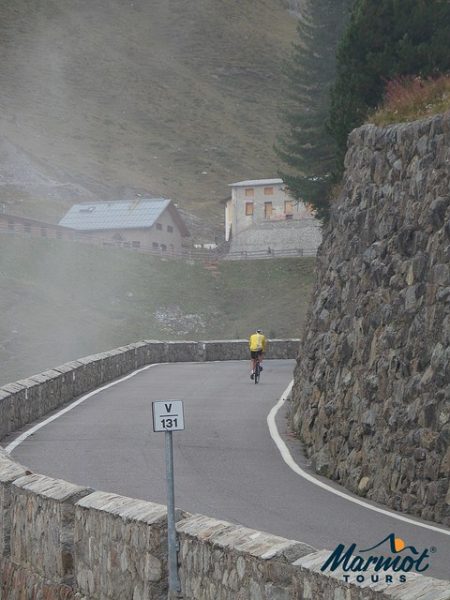
At around 2,000m of altitude, Ian told me we had 10km to ride. I thought about that. “It’s about six miles to ride from my home to Glasgow, so that’s not bad. But that still means we have more than 700m of ascent to the top.” I felt a bit ill.
The late 20s seemed very steep. There was a 10% gradient to deal with and then we were at hairpin 25. I could feel my hamstrings taking a lot of the strain and I tried to shift in my seat to re-engage my glutes.
When I could, I stood up on the pedals to give some relief to my aching butt. After a few turns of the pedals I would return to the seat to push hard again and then try to stand up for another few pedals later.
While most of the climb had been in still weather, as we climbed we felt the wind building. Snaking in one direction meant a steep gradient and a headwind, before we turned another bend to enjoy a tailwind. In places the distances between the hairpins seemed short and then long and then shorter again. I was becoming mesmerised and exhausted.
While it happened slowly, finally we found ourselves counting down the teens. Ian and I encouraged each other onwards.
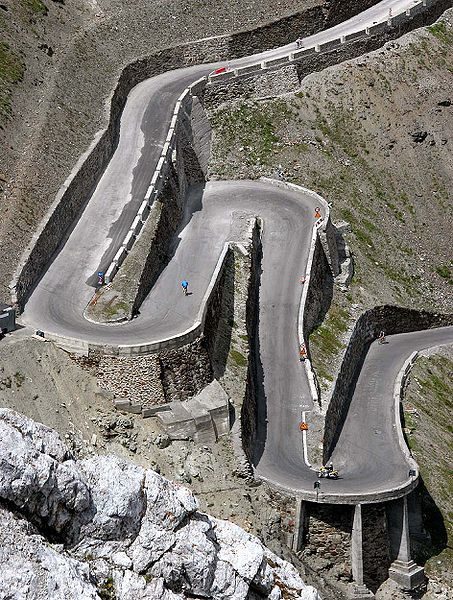
I still couldn’t believe we would ever reach the top and looking up at the steep sides, we could still barely see the pass summit.
Another rider in our group, Martin, was coming back into view ahead and we also spotted Mel. She seemed to have slowed a little towards the top although she was still looking strong and powerful. I wondered if I had anything left and whether we might catch Martin and Mel. We did not!
David, who had a sore back and was forced to get off the bike every so often to stretch out, was now nowhere to be seen having pushed hard for the final 10km or so.
As we reached the last 10 hairpins, they seemed to become tighter and steeper, rather like ascending the stairs in a lighthouse. We rode in and out of swirling cloud and the temperature dropped dramatically.
Suddenly the wind direction changed, too, although, more likely, the direction of the road had shifted to give an opposing tail and head wind. It seemed cruel to be faced with a head wind at any point on this climb.
More cruelly, the last kilometres of the Stelvio are some of the steepest and the final one cranks up to just under 10%. But we were almost there.
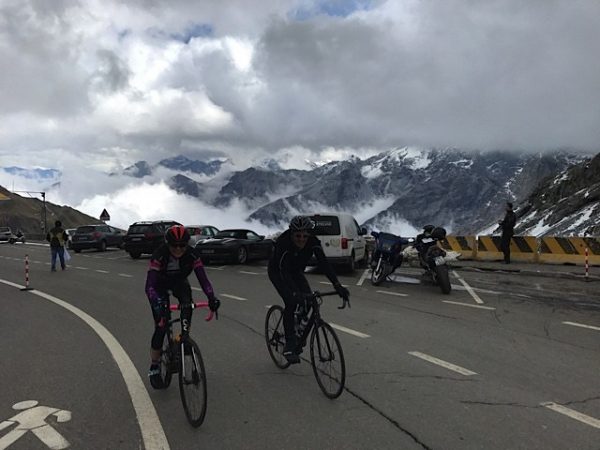
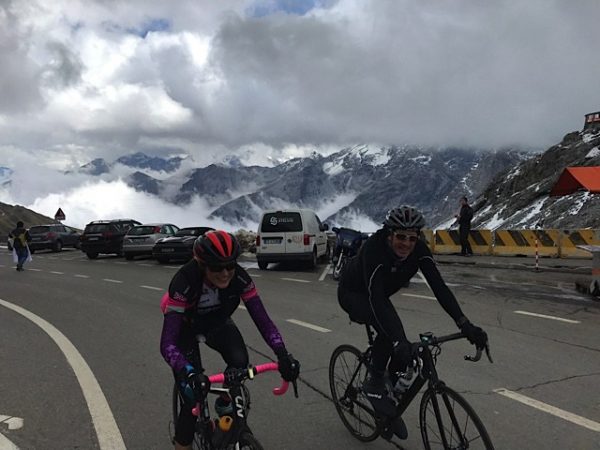
With screaming quads and a dizzy head, I made the last effort for the summit. In the distance I could see the Marmot van and some of our friends who were already at the top. As we rode to the van, Ian and I grinned at each other and gave congratulations.
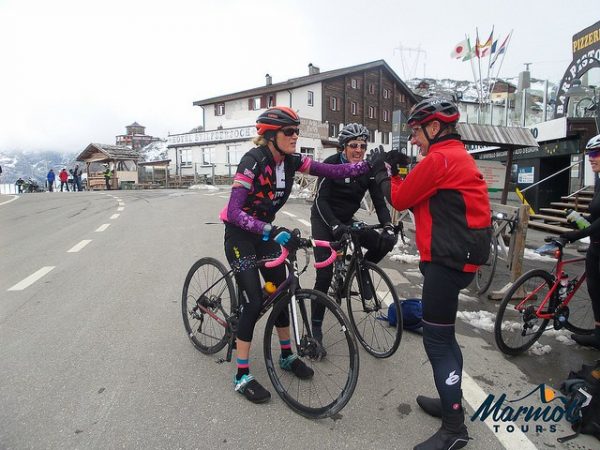
I was thrilled to have climbed the Stelvio, a mountain pass made so famous by many of the professional riders and races.
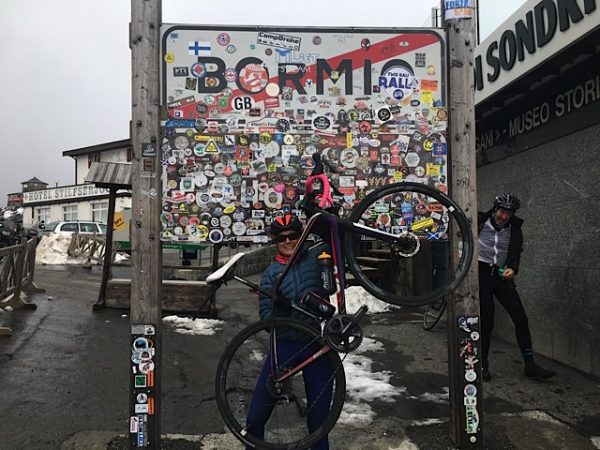
The freezing descent
As predicted, the Stelvio summit was cold. I headed into the café for a coffee and to put on all my spare clothes. The bonus of having a support van is you can change clothes and add warm layers. I swapped damp and cold baselayers and added several jackets, including a down jacket.
I also put on thermal tights and ski gloves. I knew from previous days and descending mountains that I would be cold.
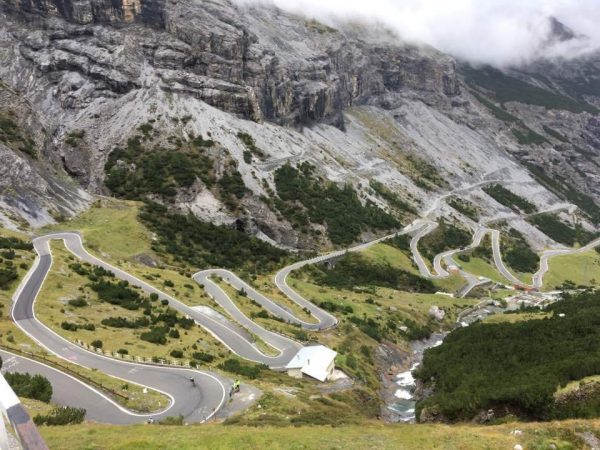
The target was the ski town of Bormio, where we would be staying for the next two nights, and the most amazing 20km or so of smooth tarmac descent.
I can report that it was freezing but fantastic. I enjoy riding downhill and the bends kept flowing through a superb landscape of mountains and valley.
As forecast, there were flurries of snow and I was pleased when I reached lower altitude and picked up signs for Bormio. I needed to give my aching hands a rest after a great deal of much-required braking.
I know people who have turned around and ridden back up Stelvio in the same day. I think I’ll save that challenge for a day of warmer weather!
